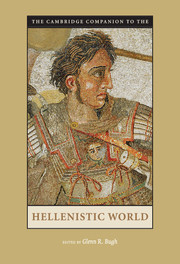Book contents
- Frontmatter
- Introduction
- 1 Alexander the Great and the Creation of the Hellenistic Age
- 2 The Hellenistic Kingdoms
- 3 The Polis and Federalism
- 4 Hellenistic Economies
- 5 The Hellenistic Family
- 6 History and Rhetoric
- 7 Material Culture
- 8 Hellenistic Art: Two Dozen Innovations
- 9 Language and Literature
- 10 Greek Religion: Continuity and Change in the Hellenistic Period
- 11 Philosophy for Life
- 12 Science, Medicine, and Technology
- 13 Hellenistic Military Developments
- 14 Greeks and Non-Greeks
- 15 Recent Trends and New Directions
- Hellenistic Dynasties
- Works Cited
- Index
15 - Recent Trends and New Directions
Published online by Cambridge University Press: 28 November 2007
- Frontmatter
- Introduction
- 1 Alexander the Great and the Creation of the Hellenistic Age
- 2 The Hellenistic Kingdoms
- 3 The Polis and Federalism
- 4 Hellenistic Economies
- 5 The Hellenistic Family
- 6 History and Rhetoric
- 7 Material Culture
- 8 Hellenistic Art: Two Dozen Innovations
- 9 Language and Literature
- 10 Greek Religion: Continuity and Change in the Hellenistic Period
- 11 Philosophy for Life
- 12 Science, Medicine, and Technology
- 13 Hellenistic Military Developments
- 14 Greeks and Non-Greeks
- 15 Recent Trends and New Directions
- Hellenistic Dynasties
- Works Cited
- Index
Summary
A Period Undervalued
In the last twenty years, there has been a quiet revolution in Hellenistic studies. To obtain reliable overviews of the period and its problems, English readers used to have to rely chiefly on large tomes or multivolume works, often decades old; specialist material was mainly in foreign-language scholarly journals. Now there is a wealth of new, high-quality yet accessible scholarship - not only in English - most noticeably in several multiauthored series. There has been a veritable explosion of interest and published work.
History has probably never had so wide an audience as now, when our televisions invite us almost nightly to meet famous historical figures. Yet, the Hellenistic period has failed to secure a place in the popular imagination about the ancient world - unless one includes in it those twin peaks of popular culture, Alexander and Kleopatra, who pinion Hellenistic history at each end, leaving its 300-year core stretched to the point of invisibility and certainly untouched by video. Probably few television viewers realize that the most familiar version of the story of Jason and the Argonauts was written at this time. One is pleasantly astonished to find a battle between two Successors of Alexander being reenacted on network television and most entertainingly. As an example of the negative impression the period still makes in some quarters, we may recall the famous eighteenth-century picture of Kleombrotos II of Sparta, held by the Tate Gallery in London.
- Type
- Chapter
- Information
- The Cambridge Companion to the Hellenistic World , pp. 315 - 326Publisher: Cambridge University PressPrint publication year: 2006
- 1
- Cited by

